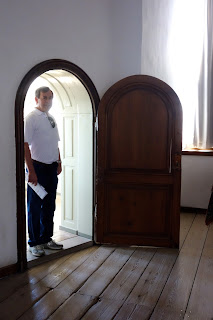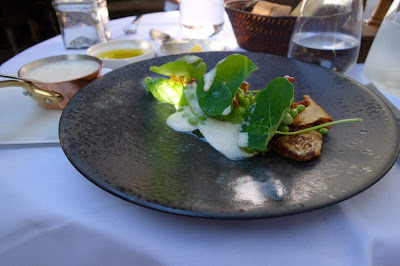Our second day in Denmark, my husband and I took a day-trip with a young, former member of the Danish Parliament to see four historic sights: The Viking Ship Museum, Roskilde Cathedral, Kronborg Castle, and Frederiksborg Palace.
Looking at the amazing feats of human ingenuity, I wondered what inspired the men? Why did they risk their lives to cross the ocean? What motivated them to plan, finance, and build castles? And why construct lavish cathedrals? Were they driven by pride or envy? Was worship a driving force? As I tried to decipher motives, I also wondered what the lives of Scandinavian ancestors could teach me?
The Viking Ship MuseumThe oldest historic ruins on the tour were five Viking ships. Between 800 and 1066 AD, Danes, Swedes, and Norwegians sailed all over Europe and the North Atlantic to plunder and trade.
The ships were not large, especially in comparison to our ocean liners, but they were seaworthy. In fact, the ships carried the warriors as far north as Iceland and as far south as Sicily. The proof is found in their building materials from many different countries.
By the end of the Viking era, the Danes themselves came under attack. To protect their capital they intentionally sank the five ships to block the fjord and deter advancing enemies. Over 900 years later in 1962, the ruins of the ships were raised from the sea and came to rest in this museum.
The ships' remains hint at their owners' motivation. It seems that the Vikings risked their lives to gain goods and land. However, the ships' skeletons also revealed what was of ultimate importance to them. When their homeland was in danger, the sailors sank their source of livelihood to protect their homes and families.
 |
| A replica of the Viking ships sits dockside for visitors to examine. |
As we left the parking lot, I processed what I had seen and concluded that the museum is a living testament to being thankful for what you have, rather than striving for more.
Roskilde CathedralThe second sight my husband and I visited was the Roskilde Cathedral, resting place of 39 Danish monarchs.
After King Harald Bluetooth converted Denmark to Christianity, he built the Roskilde Cathedral in his capital. Little did he know that this edifice would become the cemetery for generations of royalty. Already, reigning Queen Margrethe II is having an alcove constructed to house her crypt when it is needed.
On seeing all the tombs, my husband asked our guide, "Today, do Danes believe in the resurrection?"
"No," he replied.
Such skepticism contradicts the message of the cathedral which King Harald built as testament to his rejection of Nordic superstition and conversion to Christianity. The king who had his family memorial inscribed “that Harald who .... turned the Danes to Christianity”; he also had the family memorial stone illustrated with an imprint of the crucified Christ.
Putting the two opposing realities together, I wondered: Is the resurrection of King Harald's Christ as superstitious to Danes today, as Nordic deities were to the king? If there is no resurrection, where does that leave the monarchs? But, if what King Harald believed is true and there is a resurrection after death because of Christ's sacrifice, what difference would it make to the Danes? And, if there is a resurrection, how should I live?
Kronborg Castle |
| Photo: Thomas Rahbek |
Our politican-guide also took us to Kronborg castle, the landmark made famous by William Shakespeare's Viking-revenge-tale, Hamlet. In the play, Kronborg is called Elsinore, and the Danish King Frederik who built Kronborg is Hamlet. The macabre atmosphere of the actual castle is reinforced in the basement, where Hoger the Dane, the legendary hero, sits ready to retaliate if Denmark is attacked.
Kronborg Castle is located at the narrowest point between the Baltic Sea and the North Sea. The geography allowed the Danish king to collect taxes from all the trading ships passing through the straight. In fact, a third of all Denmark's expenses for several centuries were financed by that "cha-ching, cha-ching, cha-ching".
 |
| Elsinore is actually Kronborg Castle. Photo from Head in the Sand blog. |
King Frederik II's motivation for erecting the fortress is obvious; he wanted to protect his domain. The castle's name "Crown Castle" also speaks to his aim: Danish dominance of the region and his rule over Denmark.
Hm, why did we build the home we built?
As imposing as this edifice looks it would not be invincible today; I wonder what defenses we build today will seem futile in another century?
Frederiksborg PalaceNot to be outdone by his father, Frederik II, Christian IV of Denmark set out to build a palace better suited for a King than the Kronborg Castle. Construction began for Frederiksborg Palace in 1599 and lasted for 22 years. Seeing the architecture and the interior treasures, it is amazing it could be completed in such a short time.
The exterior Renaissance architecture,
the intricate brickwork detail,
the carved marble entranceways,
and sculpted bronze statuary contribute to an extravagant whole.

Yet, Christian IV was not content with an architectural masterpiece, he also commissioned extravagant gardens.
As phenomenal as the landscape and palace are the most elaborate part of Frederiksborg Palace is the chapel. It is downright opulent.
King Christian IV must have been strongly motivated to finance and oversee his over-the-top 22 year building project. What kept him going? Was his strongest motivation--self or God glorification? Is there anything I feel passionate enough to spend 22 years seeing it to completion?
Hopefully, this mini-tour of Denmark caused you to self-reflect. It sure made me think!
(My next post will be on the interiors of this castle and Frederiksborg Palace. They are inspiring!)











































































